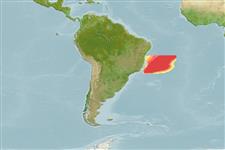Classification / Names
Nombres comunes | Sinónimos | Catalog of Fishes(Género, Especie) | ITIS | CoL | WoRMS | Cloffa
>
Stomiiformes (Lightfishes and dragonfishes) >
Stomiidae (Barbeled dragonfishes) > Melanostomiinae
Etymology: Eustomias: Greek, eu = good + Greek, stoma = mouth (Ref. 45335); posti: Named for Alfred Post..
Environment: milieu / climate zone / depth range / distribution range
Ecología
marino batipelágico; rango de profundidad 0 - 660 m (Ref. 11333). Deep-water; 13°S - 24°S
Southwest Atlantic.
Tamaño / Peso / Age
Maturity: Lm ? range ? - ? cm
Max length : 14.6 cm SL macho / no sexado; (Ref. 11333); 15.6 cm SL (female)
Short description
Morfología | Morfometría
Radios blandos dorsales (total): 25; Radios blandos anales: 38; Vértebra: 67. Two terminal bulbs separated by a long interspace, 1.3-2.5 times the length of distal bulb. Barbel length 43-50% SL. Four long filaments, arising together from distal end of distal bulb or from a short stem; all with numerous conspicuous bulblets of variable size. Distal bulb 0.9-1.6 times length of proximal-bulb. Axis of stem lightly, often sporadically pigmented; axis between bulbs and in filament lightly or unpigmented. Suggestion of spot at base of distal bulb in one specimen. External chevron-shaped or roundish striated areas unpigmented. Middorsal paired spots between occiput and dorsal-fin origin 8, sometimes 7 (Ref. 11333).
Life cycle and mating behavior
Madurez | Reproducción | Puesta | Huevos | Fecundidad | Larva
Gibbs, R.H. Jr., T.A. Clarke and J.R. Gomon, 1983. Taxonomy and distribution of the stomioid fish genus Eustomias (Melanostomiidae), I: subgenus Nominostomias. Smithson. Contrib. Zool. 380:139 p. (Ref. 11333)
IUCN Red List Status (Ref. 130435)
Threat to humans
Harmless
Human uses
Más información
Nombres comunesSinónimosMetabolismoDespredadoresEcotoxicologíaReproducciónMadurezPuestaAgregación para la puestaFecundidadHuevosEgg development
Age/SizeCrecimientoLength-weightLength-lengthLength-frequenciesMorfometríaMorfologíaLarvaDinámica larvariaReclutamientoAbundanciaBRUVS
ReferenciasAcuiculturaPerfil de acuiculturaRazasGenéticaElectrophoresesheritabilidadEnfermedadesProcesamientoNutrientsMass conversion
ColaboradoresImágenesStamps, Coins Misc.SonidosCiguateraVelocidadTipo de nataciónSuperficie branquialOtolitosCerebrosVisión
Herramientas
Special reports
Download XML
Fuentes de Internet
Estimates based on models
Preferred temperature (Ref.
123201): 24.8 - 25.7, mean 25.3 °C (based on 2 cells).
Phylogenetic diversity index (Ref.
82804): PD
50 = 0.5000 [Uniqueness, from 0.5 = low to 2.0 = high].
Bayesian length-weight: a=0.00302 (0.00117 - 0.00783), b=3.12 (2.89 - 3.35), in cm total length, based on LWR estimates for this (Sub)family-body shape (Ref.
93245).
Nivel trófico (Ref.
69278): 4.3 ±0.8 se; based on size and trophs of closest relatives
Resiliencia (Ref.
120179): Medio, población duplicada en un tiempo mínimo de 1.4-4.4 años (Assuming tmax>3).
Fishing Vulnerability (Ref.
59153): Low vulnerability (10 of 100).
